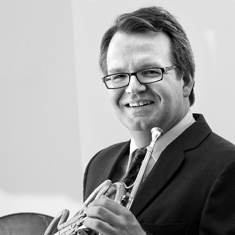 Hornist Neil Deland appeared with TSM.
Hornist Neil Deland appeared with TSM. Toronto Summer Music is certainly not one of Canada’s largest summer festivals, but the 26-day event, now in its eleventh year, has always operated with a “quality over quantity” ethos. This year’s festival is exemplary, presenting chamber music (mostly) with top-flight Canadian and international artists.
Violist Douglas McNabney has been the festival’s artistic director for the last six years and, like his predecessor, the conductor Agnes Grossmann, he likes to organize events along thematic lines. This year’s theme, “London Calling: Music in Great Britain,” has yielded some intriguing programming ideas.
In addition to its public concerts, the festival is also a teaching academy for advanced students (“on the threshold of a professional career,” says the website). In past years, these musicians were mostly heard in student concerts. But this year, for the opening concert at Koerner Hall on July 14, the festival put together a student-teacher string orchestra, conducted by Joseph Swensen. In keeping with the British theme, the programmed composers were Holst, Britten, Tippett, and Elgar.
The results were impressive. Under Swensen, the TSM Festival Strings was a supple and responsive ensemble, ranging in size from about 18 to 34 players, depending on the repertoire. Indeed, the ensemble was bursting with bright, youthful energy that made what might have been a comfy kind of program exciting.
The biggest piece of the evening was Britten’s Serenade for Tenor, Horn, and Strings, which brought to the stage tenor Nicholas Phan and horn player Neil Deland. I’ve heard Deland many times – he’s the Toronto Symphony Orchestra’s principal horn – but never before as a soloist with a small orchestra. And in this context, he excelled. Deland’s performance was remarkable for its technical perfection (we’re talking about a very ornery instrument here) and also for its range of expression. Running the gamut from tender warmth to strident brassiness, Deland’s interpretation was dramatic, nuanced, and always secure. Even Britten’s deliberately “out of tune” notes sounded just right.
Phan got off to a good start with the introspective “Pastoral” movement. But beginning with “Blow, Bugle, Blow,” he seemed to struggle with some passages that demanded a big sound. It wasn’t that he had difficulty making himself heard – he has a clear, resonant voice with no lack of strength behind it – but his pitch became unstable in his upper register.
Holst’s St. Paul’s Suite, with its famous intermingling of “Dargason” and “Greensleeves,” was a buoyant opening for the concert. And Tippett’s Concerto for Double String Orchestra was lush and sonorous.
Elgar’s Introduction and Allegro brought more soloists to the stage. The work – reminiscent of a Baroque concerto grosso – is scored for string quartet and string orchestra, and the four soloists were the members of the Parker Quartet. Unfortunately, the enthusiastic orchestra tended to swamp the soloists. But the performance offered a hint of what the festival would have to offer the following evening, in the Boston-based quartet’s own program at the University of Toronto’s Walter Hall.
The evening was titled “The Musical Union of 1865,” a reference to a concert-series that flourished at the time when chamber programs were becoming paid, public events, featuring professional musicians. On this occasion, the Parker Quartet played the kind of program that might have been presented by the Musical Union in Victorian London: works by Haydn, Beethoven, and Schubert.
From the opening of Haydn’s String Quartet in D major, Op. 71. No. 2, the quartet demonstrated brilliant technical skills, favoring an up-tempo energy. They also displayed a distinctive tone: bright, cool, and transparent, and with very little vibrato. While this sets the young ensemble apart from quartets that strive for a plush sound, the effect was more idiosyncratic than endearing.
They brought a similar approach to Beethoven’s Quartet in G major, Op. 18, No. 2, and Schubert’s Quartet No. 18, in G Major, D.887. The playing was consistently tight and unified; balance was well centered, with detailed attention to inner voices; and both phrasing and dynamics supported well-considered ideas about structure. Especially in the slow movements of the Beethoven and the Schubert, however, the quartet’s rejection of tonal warmth and tenderness hobbled what could have been an outstanding performance.
© Colin Eatock 2016
 RSS Feed
RSS Feed

